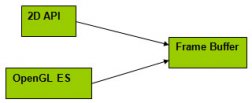
Introduction
One of the best ways to update an application with a tired two-dimensional (2D) graphical user interface (GUI) is to update its legacy look and feel with some three-dimensional (3D) effects to get more of an Apple* iPhone*–like user experience. By exploiting the Khronos* OpenGL* ES accelerator on Intel® Atom™ processors, you can make such a change without degrading the responsiveness of the UI. But rewriting a 2D application from scratch to use OpenGL* ES is usually not practical. Instead, update your 2D application to use a combination of 2D and 3D rendering by making OpenGL* ES coexist with the legacy 2D application programming interface (API) you already use. This way, your 2D GUI can still be rendered by the legacy 2D API, but then be animated in 3D with transition effects that OpenGL* ES handles well, like rotation, scaling, blending, and lighting effects.
Even when a new application is built on OpenGL* ES from the start, 2D objects—such as GUI widgets and text fonts—are often required that OpenGL* ES does not provide, so mixing 2D and 3D APIs makes more sense than you might think. In fact, the combination of 2D and 3D rendering is powerful, especially when using an application processor that offers accelerators for both, like Intel® Atom™ processors. The trick is to make them play together nicely.
2D and 3D are really different paradigms with important architectural design trade-offs that developers must face to avoid some of the limitations of OpenGL* ES on embedded systems; making efficient use of the limited resources on embedded systems is important if you want a responsive user experience. This article details and contrasts several proven solutions to combining OpenGL* ES with legacy 2D APIs that work on most embedded systems, including Linux* and Google Android. The architectural trade-offs of each approach are explained, and some important pitfalls are identified. These concepts work with either OpenGL* ES 1.1 or 2.0 on embedded Linux systems, with or without a windowing system, such as X11, Qt, or Android. Some code examples are specific to Android, which supports OpenGL* ES through both its framework API and the Native Development Kit (NDK). The API framework supports OpenGL* ES 2.0 beginning with Android 2.2.






